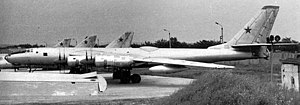Tupolev Tu-95LAL
| Tu-95LAL | |
|---|---|

| |
| The Tu-95LAL test aircraft. The bulge in the fuselage aft of the wing covers the reactor. | |
| Role | Experimental nuclear aircraft |
| Manufacturer | Tupolev |
| First flight | 1961 |
| Number built | 1 |
| Developed from | Tupolev Tu-95 |
The Tupolev Tu-95LAL, (Template:Lang-ru – Letayushchaya Atomnaya Laboratoriya – flying nuclear laboratory), experimental aircraft was a modified Tupolev Tu-95 Soviet bomber aircraft which flew from 1961 to 1965, analogous to the United States' earlier Convair NB-36H Crusader. It was intended to see if a nuclear reactor could be used to power an aircraft, primarily testing airborne operation of a reactor and shielding for components and crew.
Description
During the cold war the USSR had an experimental nuclear aircraft program, like the USA. Without the need to refuel a nuclear-powered aircraft would have greatly extended range compared to conventional designs.[1]
On 12 August 1955 the Council of Ministers of the USSR issued a directive ordering bomber-related design bureaus to join forces in researching nuclear aircraft. The design bureaus of Andrei Tupolev and Vladimir Myasishchev became the chief design teams, while N.D. Kuznetsov and A.M. Lyulka, were assigned to develop the engines. They chose to focus on the direct cycle system from the start, testing ramjets, jet engines and even turboprops.[1]
The Tupolev bureau, knowing the complexity of the task assigned to them, estimated that it would be two decades before the program could produce a working prototype. They assumed that the first operational nuclear-assisted airplane could take to the air in the late 1970s or early 1980s. In order to gain experience with the operational problems, they proposed building a flying testbed as soon as possible, mounting a small reactor in a Tupolev Tu-95M to create the Tu-95LAL.[1][2]
The VVRL-lOO reactor was fitted in the bomb bay of the aircraft, requiring an aerodynamic fairing over the top. From 1961 to 1969, the Tu-95LAL completed over 40 research flights.[3] Most of these were made with the reactor shut down. The main purpose of the flight phase was examining the effectiveness of the radiation shielding which was one of the main concerns for the engineers. Liquid sodium, beryllium oxide, cadmium, paraffin wax and steel plates were used for protection. The shielding efficiency is disputed. Most sources say that it was at least efficient enough to warrant the further work,[1][2][4] and indeed, the design of the follow-up prototype, Tu-119, was duly started.[4]
As in the US, development was curtailed on grounds of cost and environmental concerns. The emerging potential of the Inter-Continental Ballistic Missile made the expensive nuclear aircraft program superfluous, and it was scaled back.[1]
Tu-119
The next stage in the development of a nuclear-powered bomber would have been the Tupolev Tu-119, a modified Tu-95, which would have been powered by both kerosene fuelled and nuclear fuelled turboprop engines; two Kuznetsov NK-14A nuclear fuelled engines inboard fed with heat from a fuselage mounted reactor and two Kuznetsov NK-12 turboprops outboard. The Tu-119 was never completed due to the nuclear-powered bomber project being cancelled, on grounds of cost and the dire environmental impact of possible mishaps and accidents.[1]
Specifications (Tu-95LAL)
Note: the specifications given are those of the Tu-95MS where identical to the Tu-95LAL
Data from Combat Aircraft since 1945[5]
General characteristics
Performance
See also
Aircraft of comparable role, configuration, and era
References
- Citations
- ^ a b c d e f Buttler & Gordon 2004, pp. 79–80
- ^ a b Colon 2009
- ^ From the television/DVD documentary, Planes That Never Flew: The Atomic Plane, Discovery Channel Europe and Alba Communications Ltd., (c) 2003
- ^ a b TestPilot.Ru
- ^ Wilson 2000, p. 137.
- ^ a b c d Grant and Dailey 2007, p. 293.
- ^ Originally measured as 15,000 PS.
- Bibliography
- Gordon, Yefim (2004). OKB Ilyushin: A History of the Design Bureau and its Aircraft. London: Ian Allan. ISBN 1-85780-187-3.
{{cite book}}: Unknown parameter|coauthors=ignored (|author=suggested) (help) - Colon, Raul (2009). "Soviet Experimentation with Nuclear Powered Bombers". Archived from the original on 3 January 2012. Retrieved 3 January 2012.
{{cite web}}: Invalid|ref=harv(help) - Buttler, Tony; Gordon, Yefim (2004). "Chapter 6: Nuclear Power and Flying Wings". Soviet secret projects : Bombers since 1945. Hinckley: Midland Publishing. ISBN 1-85780-194-6. Retrieved 8 January 2012.
{{cite book}}: Invalid|ref=harv(help); More than one of|author=and|last1=specified (help)
